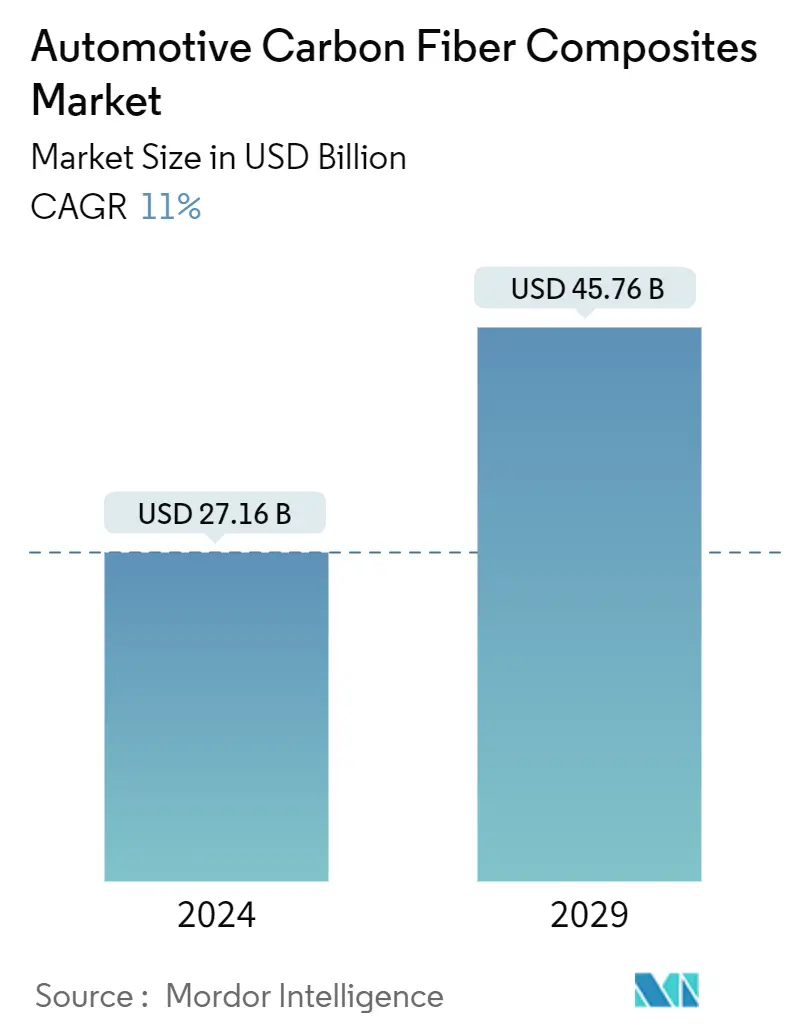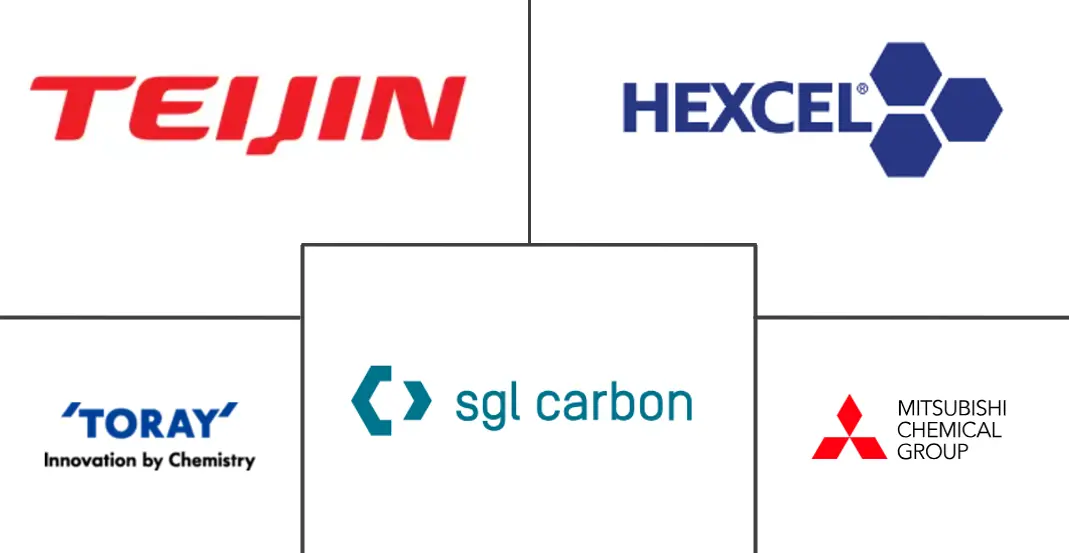Market Size of Automotive Carbon Fiber Composites Industry

| Study Period | 2019 - 2029 |
| Market Size (2024) | USD 27.16 Billion |
| Market Size (2029) | USD 45.76 Billion |
| CAGR (2024 - 2029) | 11.00 % |
| Fastest Growing Market | Asia Pacific |
| Largest Market | Asia Pacific |
Major Players
*Disclaimer: Major Players sorted in no particular order |
Automotive Carbon Fiber Composites Market Analysis
The Automotive Carbon Fiber Composites Market size is estimated at USD 27.16 billion in 2024, and is expected to reach USD 45.76 billion by 2029, growing at a CAGR of 11% during the forecast period (2024-2029).
Carbon fiber is a lightweight material with high-strength characteristics that can be designed for enhanced performance in automotive applications. It offers improvements in structural, functional, or cosmetic properties.
The rising demand for lightweight material from the automotive industry and the growing focus on fuel economy are expected to be major drivers for the automotive carbon fiber market. Amid increasingly stringent emission norms and rising fuel prices, carbon fiber is a great alternative to conventional metals as it can reduce the vehicle's weight. This can improve the fuel efficiency and performance of the engine while the fiber's physical strength limits are almost twice as high as those of conventional metals.
To make vehicles lighter, cleaner, safer, and cost-effective, leading carbon fiber suppliers are responding to the needs and expectations of vehicle OEMs, system suppliers, and customers. Major car companies, such as BMW, Audi, GM, Honda, and Polestar, have established agreements with carbon fiber material producers for mass production and are investing in their processes to support low-cost carbon fiber manufacturing.
- In June 2023, Dash-CAE launched a new carbon fiber monocoque chassis, the TR01, an affordable, versatile, and lightweight composite chassis for road cars. TR01 is suitable for any two-seat vehicle requiring a lightweight and stiff carbon fiber monocoque.
However, high costs associated with carbon fiber composites and glass fiber composites are hindering the market's growth, as their usage in low-cost vehicles could drastically increase the prices of such vehicles.
The rise in demand for electric vehicles worldwide is likely to enhance the penetration of carbon fiber to improve the range of electric vehicles, which, in turn, is likely to result in major growth for the market during the forecast period.
Automotive Carbon Fiber Composites Industry Segmentation
Carbon fiber is a lightweight material with high-strength characteristics that can be designed for enhanced performance in automotive applications.
The automotive carbon fiber market is segmented by application, vehicle type, propulsion, and geography. By application, the market is segmented into structural assembly, powertrain components, interiors, and exteriors. By vehicle type, the market is segmented into passenger cars and commercial vehicles. By propulsion, the market is segmented into internal combustion engines, battery electric vehicles, hybrid electric vehicles, plug-in hybrid electric vehicles, and fuel cell electric vehicles. By geography, the market is segmented into North America, Europe, Asia-Pacific, and Rest of the World. For each segment, the market sizing and forecast have been done based on the value (USD).
| By Application | |
| Structural Assembly | |
| Powertrain Components | |
| Interiors | |
| Exteriors |
| By Vehicle Type | |
| Passenger Car | |
| Commercial Vehicle |
| By Propulsion | |
| Internal Combustion Engine | |
| Battery Electric Vehicles | |
| Hybrid Electric Vehicles | |
| Plug-in Hybrid Electric Vehicles | |
| Fuel Cell Electric Vehicles |
| By Geography | |||||||
| |||||||
| |||||||
| |||||||
|
Automotive Carbon Fiber Composites Market Size Summary
The automotive carbon fiber market is poised for significant growth, driven by the increasing demand for lightweight materials in the automotive industry. This demand is largely fueled by the need for improved fuel economy and adherence to stringent emission norms. Carbon fiber, known for its high strength-to-weight ratio, offers substantial benefits in enhancing vehicle performance and efficiency. Major automotive manufacturers, including BMW, Audi, GM, Honda, and Polestar, are actively collaborating with carbon fiber producers to integrate these materials into their vehicles, aiming to reduce weight and improve fuel efficiency. Despite the high costs associated with carbon fiber composites, the market is expected to expand as the automotive sector shifts towards electric vehicles and sustainable transportation solutions.
The market's growth is further supported by advancements in carbon fiber technology and increasing investments in research and development by key players such as Hexcel Corporation, Mitsubishi Chemical Group, SGL Carbon SE, Teijin Limited, and Toray Industries Inc. These companies are focusing on developing cost-effective carbon fiber manufacturing processes and innovative applications to meet the rising demand. The European market, in particular, is expected to lead the growth due to the strong demand for luxury and sports cars, which often utilize carbon fiber to enhance performance and reduce weight. As the automotive industry continues to evolve with a focus on sustainability and efficiency, the integration of carbon fiber in vehicle manufacturing is anticipated to play a crucial role in meeting future market demands.
Automotive Carbon Fiber Composites Market Size - Table of Contents
-
1. MARKET DYNAMICS
-
1.1 Market Drivers
-
1.1.1 Rising Demand for Lightweight Materials from the Automotive industry
-
-
1.2 Market Restraints
-
1.2.1 High Processing and Manufacturing Cost of Composites is a Challenge
-
-
1.3 Industry Attractiveness - Porter's Five Forces Analysis
-
1.3.1 Bargaining Power of Suppliers
-
1.3.2 Bargaining Power of Buyers/Consumers
-
1.3.3 Threat of New Entrants
-
1.3.4 Intensity of Competitive Rivalry
-
1.3.5 Threat of Substitute Products
-
-
-
2. MARKET SEGMENTATION (Market Size in Value- USD)
-
2.1 By Application
-
2.1.1 Structural Assembly
-
2.1.2 Powertrain Components
-
2.1.3 Interiors
-
2.1.4 Exteriors
-
-
2.2 By Vehicle Type
-
2.2.1 Passenger Car
-
2.2.2 Commercial Vehicle
-
-
2.3 By Propulsion
-
2.3.1 Internal Combustion Engine
-
2.3.2 Battery Electric Vehicles
-
2.3.3 Hybrid Electric Vehicles
-
2.3.4 Plug-in Hybrid Electric Vehicles
-
2.3.5 Fuel Cell Electric Vehicles
-
-
2.4 By Geography
-
2.4.1 North America
-
2.4.1.1 United States
-
2.4.1.2 Canada
-
2.4.1.3 Rest of North America
-
-
2.4.2 Europe
-
2.4.2.1 Germany
-
2.4.2.2 United Kingdom
-
2.4.2.3 France
-
2.4.2.4 Italy
-
2.4.2.5 Rest of Europe
-
-
2.4.3 Asia-Pacific
-
2.4.3.1 China
-
2.4.3.2 Japan
-
2.4.3.3 India
-
2.4.3.4 South Korea
-
2.4.3.5 Rest of Asia-Pacific
-
-
2.4.4 Rest of the World
-
2.4.4.1 South America
-
2.4.4.2 Middle East and Africa
-
-
-
Automotive Carbon Fiber Composites Market Size FAQs
How big is the Automotive Carbon Fiber Composites Market?
The Automotive Carbon Fiber Composites Market size is expected to reach USD 27.16 billion in 2024 and grow at a CAGR of 11% to reach USD 45.76 billion by 2029.
What is the current Automotive Carbon Fiber Composites Market size?
In 2024, the Automotive Carbon Fiber Composites Market size is expected to reach USD 27.16 billion.

